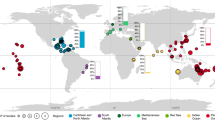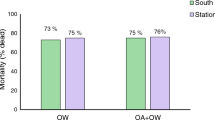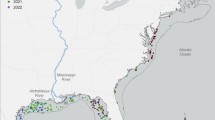Abstract
The impacts of ocean acidification on coral reef macroalgal community composition and metabolism have implications for the habitat supporting capacity of future reefs. In this pilot study, we use co-located semi-hourly measurements of total dissolved inorganic carbon (DIC), total alkalinity, and the stable carbon isotope composition of DIC (δ13CDIC) over a 27 + h period from Tetiaroa Atoll, French Polynesia, to investigate the potential for reef carbonate chemistry to record information related to benthic photosynthetic community composition and response to natural gradients in ambient acidity and dissolved carbon dioxide. The results of this preliminary sampling and modeling exercise suggest that Tetiaroa’s macroalgal communities express plastic carbon-concentrating mechanisms (CCMs) over daily cycles of productivity but may potentially vary this expression as a function of ambient CO2 and acidity within the ecosystem. Additional studies are, therefore, underway to investigate the implications of these observations for reef macroalgal compositional differences under rapidly acidifying oceans.

Similar content being viewed by others
Data availability
Data are available through Mendeley Data at https://doi.org/10.17632/6pfx6cpp39.1
References
Agostini S, Harvey BP, Wada S, Kon K, Milazzo M, Inaba K, Hall-Spencer JM (2018) Ocean acidification drives community shifts towards simplified non-calcified habitats in a subtropical−temperate transition zone. Sci Rep 8:5–10
Andersson AJ, Gledhill D (2013) Ocean acidification and coral reefs: effects on breakdown, dissolution, and net ecosystem calcification. Ann Rev Mar Sci 5:321–348
Beardall J, Raven JA (2013) Limits to phototrophic growth in dense culture: CO2 supply and light. Algae for Biofuels and Energy. Springer Netherlands, Dordrecht, pp 91–97
Bolden IW (2020) Constructing a toolbox of geochemical indicators of community composition shifts in coral reef ecosystems under stress. Ph.D. University of Washington
Bolden IW, Sachs JP, Gagnon AC (2019) Temporally-variable productivity quotients on a coral atoll: Implications for estimates of reef metabolism. Mar Chem 217:103707
Bolden IW, Satkoski A, Lassiter JC, Sachs JP, Gagnon AC (2023) Temporal variability in seawater Sr/Ca ratios within a coral atoll as an indicator of marine calcifier community diversity. Geochim Cosmochim Acta 357:92–104
Carvalho MC, Santos IR, Maher DT, Cyronak T, McMahon A, Schulz KG, Eyre BD (2015) Drivers of carbon isotopic fractionation in a coral reef lagoon: predominance of demand over supply. Geochim Cosmochim Acta 153:105–115
Collin A, Archambault P, Planes S (2014) Revealing the regime of shallow coral reefs at patch scale by continuous spatial modeling. Front Mar Sci 1:1–15
Contreras-Silva AI, Tilstra A, Migani V, Thiel A, Pérez-Cervantes E, Estrada-Saldívar N, Elias-Ilosvay X, Mott C, Alvarez-Filip L, Wild C (2020) A meta-analysis to assess long-term spatiotemporal changes of benthic coral and macroalgae cover in the Mexican Caribbean. Sci Rep 10:1–12
Cornwall CE, Revill AT, Hall-Spencer JM, Milazzo M, Raven JA, Hurd CL (2017) Inorganic carbon physiology underpins macroalgal responses to elevated CO2. Sci Rep 7:1–12
Dickson AG, Sabine CL, Christian JR (2007) Guide to best practices for ocean CO2 measurements. PICES Spec Publ 3:191
Edmunds PJ, Leichter JJ, Johnston EC, Tong EJ, Toonen RJ (2016) Ecological and genetic variation in reef-building corals on four society islands. Limnol Oceanogr 61:543–557
Edmunds PJ, Leichter JJ (2016) Spatial scale-dependent vertical zonation of coral reef community structure in French Polynesia. Ecosphere 7:1–14
Enochs IC, Manzello DP, Donham EM, Kolodziej G, Okano R, Johnston L, Young C, Iguel J, Edwards CB, Fox MD, Valentino L, Johnson S, Benavente D, Clark SJ, Carlton R, Burton T, Eynaud Y, Price NN (2015) Shift from coral to macroalgae dominance on a volcanically acidified reef. Nat Clim Chang 5:1–9
Eyre BD, Cyronak T, Drupp P, De Carlo EH, Sachs JP, Andersson AJ (2018) Coral reefs will transition to net dissolving before end of century. Science 359:908–911
Fabricius KE, Langdon C, Uthicke S, Humphrey C, Noonan S, De’ath G, Okazaki R, Muehllehner N, Glas MS, Lough JM (2011) Losers and winners in coral reefs acclimatized to elevated carbon dioxide concentrations. Nat Clim Chang 1:165–169
Falkowski PG, Raven JA (2007) Aquatic Photosynthesis. Princeton University Press
Hall-Spencer JM, Rodolfo-Metalpa R, Martin S, Ransome E, Fine M, Turner SM, Rowley SJ, Tedesco D, Buia MC (2008) Volcanic carbon dioxide vents show ecosystem effects of ocean acidification. Nature 454:96–99
Hepburn CD, Pritchard DW, Cornwall CE, Mcleod RJ, Beardall J, Raven JA, Hurd CL (2011) Diversity of carbon use strategies in a kelp forest community: implications for a high CO2 Ocean. Glob Chang Biol 17:2488–2497
Jeanson M, Anthony EJ, Etienne S, Dolique F (2014) Morphodynamic characterization of beaches on a Pacific atoll island: Tetiaroa, French Polynesia. J Coast Res 70:176–181
Koweek DA, Forden A, Albright R, Takeshita Y, Mucciarone DA, Ninokawa A, Caldeira K (2019) Carbon isotopic fractionation in organic matter production consistent with benthic community composition across a coral reef flat. Front Mar Sci 5:1–14
Kroopnick PM (1985) The distribution of 13C of ΣCO2 in the world oceans. Deep Sea Res Part a, Oceanogr Res Pap 32:57–84
Maliao RJ, Turingan RG, Lin J (2008) Phase-shift in coral reef communities in the florida keys national marine sanctuary (FKNMS), USA. Mar Biol 154:841–853
Quay PD, Tilbrook B, Wong CS (1992) Oceanic uptake of fossil fuel CO2: Carbon-13 evidence. Science 256:74–79
Quay PD (2017) The 13C/12C stable carbon isotopic ratio of the dissolved inorganic carbon from samples collected on the GEOTRACES EPZT cruise (R/V Thomas G. Thompson TN303) in the Eastern Tropical South Pacific from October to December 2013
Raven JA, Johnston AM, Newman JR, Scrimgeour CM (1994) Inorganic carbon acquisition by aquatic photolithotrophs of the Dighty Burn, Angus, U.K.: uses and limitations of natural abundance measurements of carbon isotopes. New Phytol 127:271–286
Raven JA, Johnston AM, Kübler JE, Korb R, Mcinroy SG, Handley LL, Scrimgeour CM, Walker DI (2002) Mechanistic interpretation of carbon discrimination by marine macroalgae and seagrasses. Funct Plant Biol Contin Aust J Plant Physiol 29:355–378
Raven JA, Giordano M, Beardall J, Maberly SC (2012) Algal evolution in relation to atmospheric CO2: carboxylases, carbon-concentrating mechanisms and carbon oxidation cycles. Philos Trans R Soc B: Biol Sci 367:493–507
Raven JA (1997) Inorganic carbon acquisition by marine autotrophs. Adv Bot Res 27:85–209
Stanca E, Parsons ML (2017) Phytoplankton diversity along spatial and temporal gradients in the Florida Keys. J Plankton Res 39:531–549
Stepien CC (2015) Impacts of geography, taxonomy and functional group on inorganic carbon use patterns in marine macrophytes. J Ecol 103:1372–1383
Stepien CC, Pfister CA, Wootton JT (2016) Functional traits for carbon access in macrophytes. PLoS One 11:1–19
Swart PK, Szmant A, Porter JW, Dodge RE, Tougas JI, Southam JR (2005) The isotopic composition of respired carbon dioxide in scleractinian corals: implications for cycling of organic carbon in corals. Geochim Cosmochim Acta 69:1495–1509
Weber JN, Woodhead PMJ (1971) Diurnal variations in the isotopic composition of dissolved inorganic carbon in seawater from coral reef environments. Geochim Cosmochim Acta 35:891–902
Young EB, Beardall J (2005) Modulation of photosynthesis and inorganic carbon acquisition in a marine microalga by nitrogen, iron, and light availability. Can J Bot 83:917–928
Acknowledgements
We are thankful for the support of James and Marsha Seeley (Medina, WA) and the laboratory, field facilities, and personnel support provided by the Tetiaroa Society. Additional thanks to L. Brandkamp (UW), D. Anderson (UW), J.A. Gregersen (UW), N.P. Roden (UW), and C.P. Saenger (UW) for aiding in sample collection; B. Kain (Seattle Preparatory School), C. Brichard (UW), and J. Butwin (UW) for aiding with DIC and TA sample analyses; J. Stutsman (UW) and T. Rolfe (UW) for δ13C sample processing and analyses; and P.D. Quay (UW) for helpful discussions on mechanisms responsible for trends in data. Funding support to IWB provided by the National Science Foundation Graduate Research Fellowship, Achievement Rewards for College Scientists (ARCS) Fellowships, the Social Science Research Council Graduate Studies Enhancement Grant, and NSF award number 1068839.
Author information
Authors and Affiliations
Corresponding author
Ethics declarations
Conflict of interest
On behalf of all authors, the corresponding author states that there is no conflict of interest.
Additional information
Publisher's Note
Springer Nature remains neutral with regard to jurisdictional claims in published maps and institutional affiliations.
Supplementary Information
Below is the link to the electronic supplementary material.
Rights and permissions
Springer Nature or its licensor (e.g. a society or other partner) holds exclusive rights to this article under a publishing agreement with the author(s) or other rightsholder(s); author self-archiving of the accepted manuscript version of this article is solely governed by the terms of such publishing agreement and applicable law.
About this article
Cite this article
Bolden, I.W., Sachs, J.P. & Gagnon, A.C. Geochemical evidence of temporal ecosystem photosynthetic plasticity within a pristine coral atoll. Coral Reefs 43, 795–800 (2024). https://doi.org/10.1007/s00338-024-02493-w
Received:
Accepted:
Published:
Issue Date:
DOI: https://doi.org/10.1007/s00338-024-02493-w




